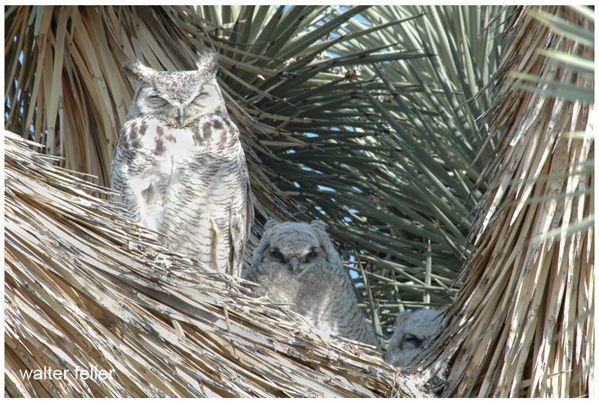Great Horned Owl
Bubo virginianus
A very large owl with adults posessing large ear tufts, a reddish face, a white patch on the
throat and yellow eyes. The ear tufts are not actually ears, but just tufts of feathers. The underparts
are light with brown barring; the upper parts are mottled brown. The legs and feet are covered in
feathers up to the talons.
Their breeding habitat is almost anywhere across North America and parts of South America. They are often
found in urban and suburban settings and are a common backyard bird. They often take over a nest used by
some other large bird, sometimes adding feathers to line the nest but usually not much more. In the
Sonoran desert, they often take over abandoned
red-tailed hawk
nests in the arms of saguaro cacti. In the Mojave desert, in the branches of a
Joshua tree.
They are permanent residents, but may wander after the nesting season.
These birds hunt at night by waiting on a high perch and swooping down on prey. They mainly eat
small mammals such as rats, mice,
rabbits
and skunks, as well as small birds, including smaller owls. In northern regions, they may let
uneaten food freeze and then thaw it out later using their own body heat.
They have excellent hearing and exceptional vision in low light. Compared to humans, owls have a
much sharper depth of perception to their hearing. This is possible because owl ears are not placed
in the same position on either side of their head: the right ear is typically set higher in the skull
and at a slightly different angle. By tilting or turning its head until the sound is the same in
each ear, an owl can pinpoint both the direction and the distance to the source of a sound.
Life History Account
Great Horned Owl
Bubo virginianus
Family: Strigidae Order: Strigiformes Class: Aves
DISTRIBUTION, ABUNDANCE, AND SEASONALITY
A common, permanent resident throughout the state from sea level to 2100 m (0-7000 ft),
occasionally to 3200 m (10,500 ft). Exploits a variety of forests with meadows and other
openings, extending from valley foothill hardwood to mixed conifer habitats. Commonly feeds
and breeds in riparian, conifer, chaparral, and
desert habitats.
SPECIFIC HABITAT REQUIREMENTS
Feeding: Usually makes low, rapid flight from perch to capture
prey
on ground.
Rabbits,
rodents,
and other small to medium-sized mammals usually make up 90% of the diet. Also
eats
birds
(occasionally smaller or
young raptors; Wiley 1975b), amphibians,
reptiles, fish,
and arthropods. Frequently forages in meadows and woodland or forest openings, or along
edges.
Cover: Requires trees with dense foliage for roosting; often uses thickly wooded canyons.
Reproduction: Nests in abandoned hawk, crow,
raven,
or squirrel nest, in cave or crevice, on cliff ledge, occasionally in snag or tree cavity (Call 1978).
Nests in trees usually 12-21 m (40-70 ft) above ground.
Water: Most water requirements probably met from prey (Bartholomew and Cade 1963).
Will drink water in captivity.
Pattern: Frequents forested habitats; feeds especially in edges, openings, and meadows.
SPECIES LIFE HISTORY
Activity Patterns: Yearlong, nocturnal and crepuscular activity.
Seasonal Movements/Migration: Mostly not migratory, but will move upslope and
downslope in response to weather conditions.
Home Range: In Wyoming, home range varied from 1.2 to 2.9 km˛ (0.4 to 1.1 mi˛), with an
average of 2.1 km˛ (0.8 mi˛). In eastern Oregon, home range averaged 12.1 km˛ (4.7 mi˛). In
Michigan farmland, nesting density varied from 0.04 to 0.08 pair per km˛ (0.1 to 0.2 per mi˛),
and wintering density varied from 0.12 to 0.15 individuals per km˛ (0.3 to 0.4 per mi˛)
(Craighead and Craighead 1956).
Territory: Average territory was 65 ha (160 ac) in oak habitats in Kansas (Fitch 1958).
Male defends territory throughout breeding season more aggressively than female.
Reproduction: Breeds from mid-January through June, peak usually March through May.
Clutch size 1-6; average 3; often laid in February or March. Incubation 26-35 days,
semialtricial young fledge in 35-56 days. Male may assist with nest activities. Craighead and
Craighead (1956) reported fledging success (young fledged/eggs laid) of 27% and 50% in
Michigan, and 89% in Wyoming.
Niche:
Golden eagles
and humans may be the only
predators
(Hoechlin 1976). Competitors for food include Cooper's hawks,
American kestrels,
and other large owls. Population numbers respond to
prey
abundance.
The Great horned owl is a raptor.
For more information on raptors, click here.
Source:
CDFW California Wildlife Habitat Relationships. Accessed [N/A]
https://wildlife.ca.gov/Data/CWHR